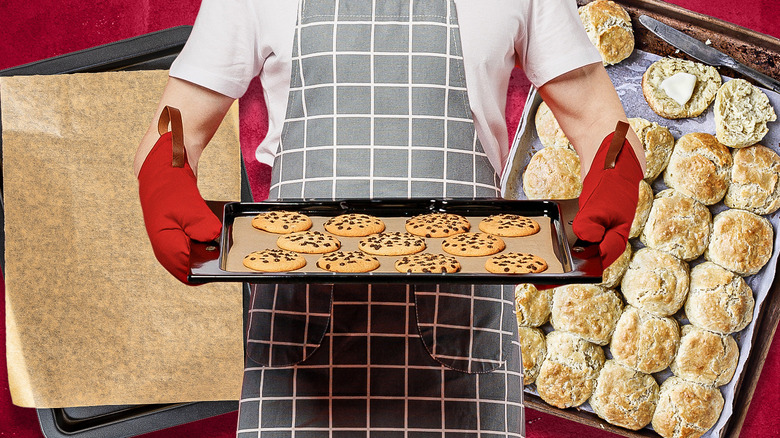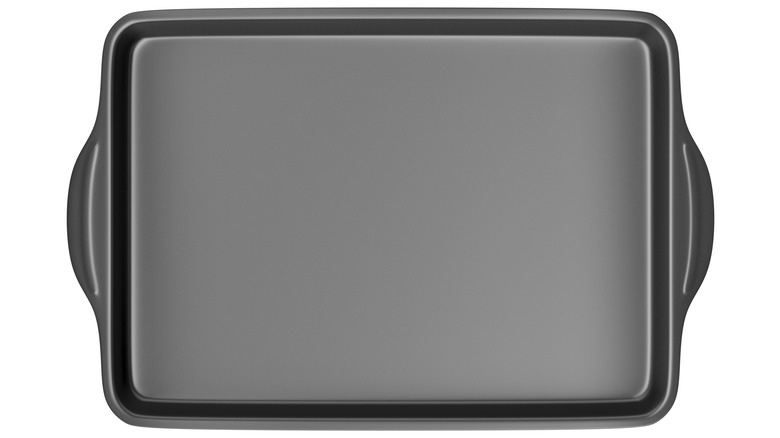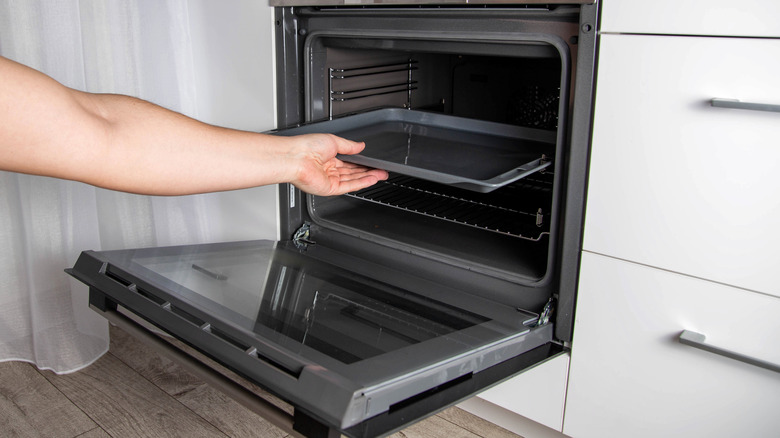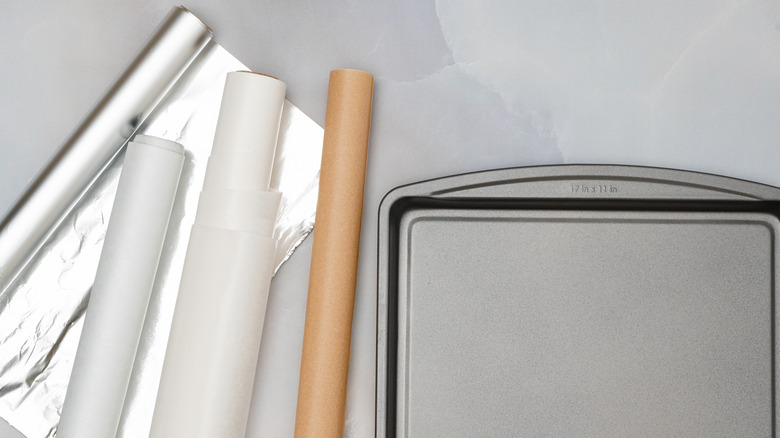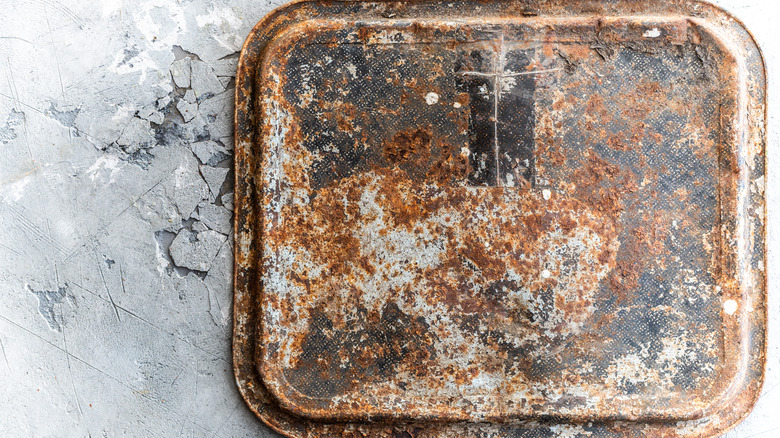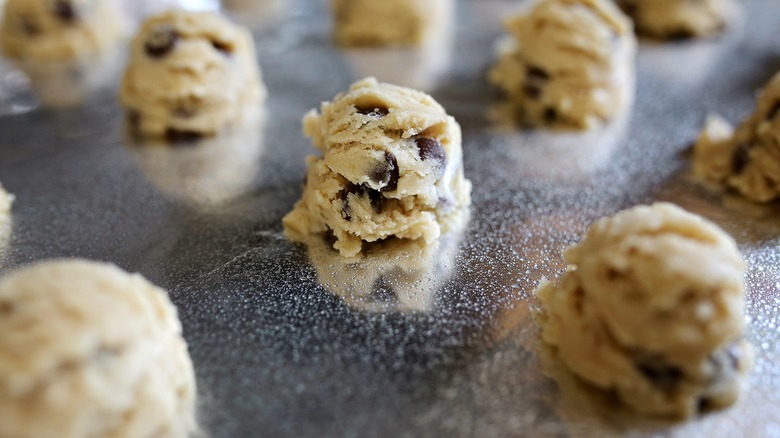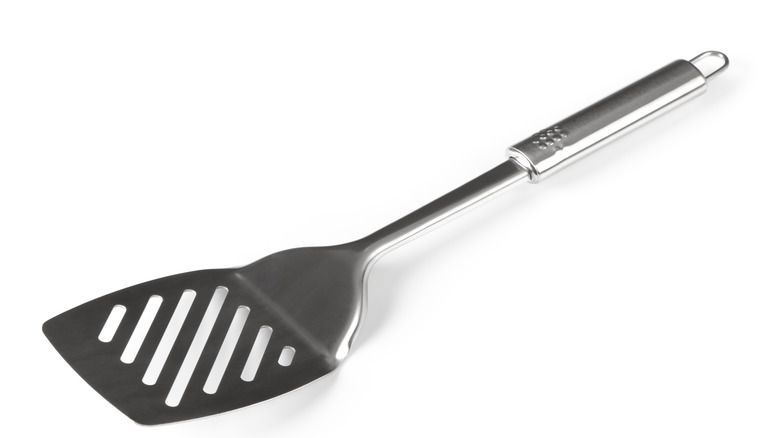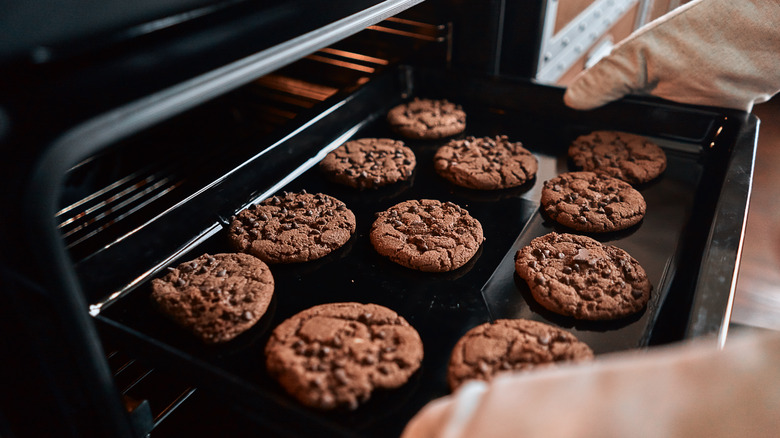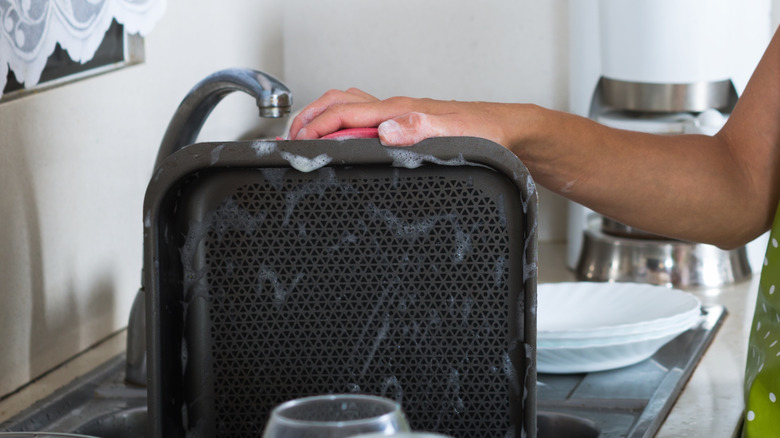8 Baking Sheet Mistakes You Should Avoid, According To A Personal Chef
Baking sheets are a staple tool in a well-stocked kitchen. They can be used for numerous tasks, from baking your favorite chocolate chunk cookies to serving as a makeshift charcuterie board and making dinnertime a breeze with sheet pan dinners.
During my career as a personal chef, cooking for clients in their homes for over 15 years, baking sheets were instrumental in making my job easier. I've used them to roast meats and vegetables and in a number of ways outside of their intended purpose, like as trays to stay organized during meal prep.
Baking sheets are an extremely functional and versatile item that every cook should have. They are indispensable tools for home cooks and professional chefs alike, offering versatility, durability, and, if used and cared for properly, years of great performance. While using baking sheets in your kitchen might seem straightforward, there are some mistakes you can make when purchasing, using, and cleaning them. These tips will help you avoid the most common mistakes people make when using baking sheets.
Choosing the wrong pan
There's more to choosing a baking sheet than you might think. One trip down a kitchen store's cookware aisle might overwhelm you with the variety of options available. Should you choose a small sheet or a large one? Do you need a nonstick coating? Should your baking sheet have a rim? Is a baking sheet with a light or dark color the right one for you?
Consider how you'll use your baking sheet before purchasing it. If you're looking for a sheet to bake cookies on, choose a rimless baking sheet. The terms "cookie sheet" and "baking sheet" are used interchangeably, but they're not the same. Baking sheets have a raised rim on all four sides of the pan. Cookie sheets typically have only one raised edge meant for use as a handle. Rimmed baking sheets can be used to bake cookies and other foods like meats and vegetables. The rim helps keep the juices from spilling.
Color is another thing to consider. Pans with a darker surface will cause your food to brown more because darker colors absorb more heat.
The half-sheet pan, which measures 13 by 18 inches, is the standard baking sheet size most chefs use. They were my go-to at work and what I use in my home kitchen. Larger and smaller options are available. Choose the best size for your cooking needs. Nonstick pans make clean-up a breeze, but the coating will eventually wear off. Uncoated pans may last longer.
Forgetting to preheat the baking sheet
If you're cooking foods in the oven, chances are one of the first steps in your recipes will be to preheat the oven. When I cooked for clients, turning the oven on to get it up to temperature was the first thing I did upon arrival, even before I unpacked groceries and supplies. This allowed the oven to come to the temperature I needed before adding any food to it, saving time and ensuring my food was cooked evenly and accurately with consistent results.
Preheating the oven is a critical step in cooking, whether you're baking a sweet treat or roasting a chicken, but preheating your baking sheet is a step that should only be done when cooking savory items. These foods will benefit from a hot baking sheet. Adding cookie dough to a hot baking sheet will cause your cookies to spread too much and not cook properly.
Meats and vegetables thrive when added to a hot baking sheet. The hot pan causes your food to cook more evenly and cuts down your cooking time. When you add food to a baking sheet without preheating it, the bottom surface of the food takes longer to cook because it has to wait for the pan to get hot. The top of the food gets a headstart because it's exposed to the heat source directly.
Not prepping the baking sheet before using it
There's not much worse than taking the time to prepare food and struggling to remove it from the pan because it's stuck. If you're using a baking sheet, this sticking is likely caused by failing to appropriately prep the pan before using it.
I recommend treating your baking sheets the same as you would any pan you use to cook on your stovetop. Most recipes instruct you to add some form of coating to the pan before cooking. Whether it's olive oil, a quick blast of nonstick spray, or a liquid like water or stock, prepping the pan is a crucial first step. With a baking sheet, you can prevent food from sticking by coating the pan or lining it. A thin coat of oil or nonstick spray will minimize sticking and make your pan easier to clean.
Lining your pans is another option. Lining your baking sheet with aluminum foil will keep food from sticking and can cause foods like bacon to cook up crispier. Parchment paper works especially well with cookies and baked goods, preventing them from sticking and allowing easy removal from the pan. Avoid using wax paper to line pans. It's nonstick but not heat-resistant.
Using a warped baking sheet
It's happened to all of us at some point. You place a baking sheet into a hot oven and, moments later, are startled by a loud popping sound coming from the oven. A quick glance in the oven shows your baking sheet is suddenly misshapen for no apparent reason. Warped baking sheets occur when your baking sheet heats unevenly. As your baking sheet warms, the metal in the pan expands. The thicker sides of your baking sheet will take longer to heat up than the thinner center, and the pressure this creates where the sides meet causes the metal to buckle or warp.
The problem with warped baking sheets is they can make it difficult for your food to cook evenly and properly. The shift in position on the baking sheet can affect the food's ability to brown evenly or cook at the same speed. Most warped baking sheets will return to their normal shape once they cool down. In case yours doesn't, you may be able to salvage your pan by heating it in the oven at 200 degrees Fahrenheit for 10 minutes, layering it between two kitchen towels, and gently hammering the sheet back into shape.
My experience in commercial and home kitchens has taught me that the easiest way to avoid warping is to purchase sturdy, high-quality baking sheets. You can also reduce the risk of warping by preheating your baking sheet and ensuring your food is evenly distributed across the pan.
Crowding food on your baking sheet
Adding too much food to your pots and pans is one of the most common cooking mistakes you can make. It can be hard to resist the temptation of piling food high in order to cook more at one time, but the cons definitely outweigh the pros. As a cooking instructor, I warn my students that overcrowding a pan, whether a baking sheet or a saute pan, lowers its temperature, which can cause the food to not cook properly. When a pan is crowded, there isn't adequate room around the food for the hot air to circulate. This can slow down the cooking process, prevent browning, and prevent food from crisping properly.
Baking sheets are no different. Crowding cookie dough on a baking sheet will keep your cookies from spreading correctly. They will likely stick together, won't cook evenly, and may burn. When other foods, like meats or vegetables, are crowded on a sheet pan, they will likely steam instead of roast because steam is created when heat is trapped under clumps or piles of food.
Always give your food room to breathe on the baking sheet, with plenty of space for air to circulate and excess moisture to evaporate away.
Using sharp, metal utensils on nonstick baking sheets
Nonstick baking sheets are designed to provide an easy-release surface for food, preventing it from sticking and making cleanup a breeze. When I cooked for clients, nonstick baking sheets saved me hours of cleanup time. The coating works like magic to keep even the stickiest foods from lingering on your pan's surface. Even notoriously sticky foods like honey and eggs are no challenge for a good nonstick baking sheet. To keep your nonstick baking sheets looking brand new, there's one thing you should never do — use sharp, metal utensils on them.
Most pans are made of metal, which is inherently durable, but nonstick baking sheets are more delicate than you might think, and using sharp utensils on them can be bad for your pan and your health. The nonstick surface on your baking sheet is just a coating applied to the pan when it's manufactured. Utensils made of metal or with sharp points or edges can easily damage that coating. Once the coating is chipped, it's easy for more of it to chip off into your food, which means you're ingesting the coating and all of the chemicals used to create it.
Keep your nonstick baking sheets in the best condition by playing it safe with wooden or silicone utensils. You'll be able to manipulate the food without damaging your baking sheet.
Forgetting to rotate your baking sheet
Rotating your baking sheets during cooking is a simple technique that can significantly improve the quality and consistency of your baked goods. If you've ever baked a sheet of cookies or roasted a tray of vegetables and found cookies on one side of the tray browner than the other half or vegetables overcooked or burnt on one section of the baking sheet, you likely forgot to rotate your baking sheet.
I've learned from years of cooking in different kitchens that even the best ovens can have variations in heat distribution, with some areas being hotter than others. Those variations can be just a few degrees, which can be enough to alter your outcome. By rotating the baking sheets halfway through the cooking time, you expose all sides of your food to your oven's different hot spots, promoting uniform browning and cooking.
To rotate your baking sheets, simply use an oven mitt or kitchen towel to turn the sheet pan a full 180 degrees so the left side of the baking sheet ends up on the right side of the oven. If you're using two baking sheets at once, you'll want to rotate the pans and switch their positions, transferring the tray on the top rack to the bottom and vice versa.
Not handwashing them
Washing dishes is probably the least appealing part of spending time in the kitchen. It might be fun to cook up your favorite foods, but tackling the pile of dishes in the sink at the end of your cooking can be both a letdown and a chore most of us would prefer to skip. Many items in your kitchen can be safely tucked into your trusty dishwasher for cleaning, but baking sheets are not one of them. After spending hours meal-prepping and catering special occasions, it has crossed my mind to add my pile of dirty baking sheets to the dishwasher with the rest of my dishes, but the immediate convenience is outweighed by the threat of permanently damaging my pans.
Putting your baking sheets in the dishwasher is generally not recommended for several reasons. First, your dishwasher could damage baking sheets. Most baking sheets and sheet pans are made from materials like aluminum or stainless steel, which can undergo an adverse reaction from the harsh detergents in some dishwasher liquids. This can lead to discoloration and surface damage over time, which can compromise their performance. It's also a bad idea to put nonstick cookware in the dishwasher because the chemicals in the detergents can compromise your nonstick coating. In addition, the baking sheets can potentially get damaged by other items hitting them in the dishwasher.
Keep your baking sheets in tip-top shape by handwashing them.
